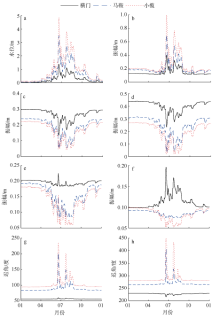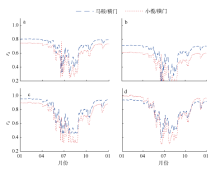| [1] |
欧素英, 杨清书, 2004. 珠江三角洲网河区径流潮流相互作用分析[J]. 海洋学报, 26(1): 125-131.
|
|
OU SUYING, YANG QINGSHU, 2004. Interaction of fluctuating river flow with a barotropic tide in river network of the Zhujiang Delta[J]. Acta Oceanologica Sinica, 26(1): 125-131 (in Chinese).
|
| [2] |
欧素英, 杨清书, 2008. 人工神经网络模型在航道、港口潮水位预报中的应用[J]. 水利水运工程学报, (2): 67-70.
|
|
OU SUYING, YANG QINGSHU, 2008. Back-propagation artificial neural network model for prediction of tidal water level[J]. Hydro-Science and Engineering, (2): 67-70 (in Chinese).
|
| [3] |
CAI HUAYANG, SAVENIJE H H G, YANG QINGSHU, et al, 2012. Influence of river discharge and dredging on tidal wave propagation: Modaomen Estuary case[J]. Journal of Hydraulic Engineering, 138(10): 885-896.
|
| [4] |
GODIN G, 1985. Modification of river tides by the discharge[J]. Journal of Waterway, Port, Coastal, and Ocean Engineering, 111(2): 257-274.
|
| [5] |
GUO LEICEHNG, VAN DER WEGEN M, JAY D A, et al, 2015. River-tide dynamics: exploration of nonstationary and nonlinear tidal behavior in the Yangtze River estuary[J]. Journal of Geophysical Research, 120(5): 3499-3521, doi: 10.1002/2014JC010491.
|
| [6] |
JAY D A, FLINCHEM E P, 1997. Interaction of fluctuating river flow with a barotropic tide: A demonstration of wavelet tidal analysis methods[J]. Journal of Geophysical Research, 102(C3): 5705-5720.
|
| [7] |
KUKULKA T, JAY D A, 2003. Impacts of Columbia River discharge on salmonid habitat: 1. A nonstationary fluvial tide model[J]. Journal of Geophysical Research, 108(C9): 3293, doi: 10.1029/2002JC001382.
|
| [8] |
LEE T L, 2004. Back-propagation neural network for long-term tidal predictions[J]. Ocean Engineering, 31(2): 225-238.
|
| [9] |
MATTE P, JAY D A, ZARON E D, 2013. Adaptation of classical tidal harmonic analysis to nonstationary tides, with application to river tides[J]. Journal of Atmospheric and Oceanic Technology, 30(3): 569-589.
|
| [10] |
MATTE P, SECRETAN Y, MORIN J, 2014. Temporal and spatial variability of tidal-fluvial dynamics in the St. Lawrence fluvial estuary: an application of nonstationary tidal harmonic analysis[J]. Journal of Geophysical Research, 119(9): 5724-5744, doi: 10.1002/2014JC009791.
|
| [11] |
PAWLOWICZ R, BEARDSLEY B, LENTZ S, 2002. Classical tidal harmonic analysis including error estimates in MATLAB using T_TIDE[J]. Computers & Geosciences, 28(8): 929-937.
|
| [12] |
SASSI M G, HOITINK A J F, 2013. River flow controls on tides and tide-mean water level profiles in a tidal freshwater river[J]. Journal of Geophysical Research, 118(9): 4139-4151, doi: 10.1002/jgrc.20297.
|
 ), Qingshu YANG, Hao YANG, Shuai HU
), Qingshu YANG, Hao YANG, Shuai HU









